You are using an out of date browser. It may not display this or other websites correctly.
You should upgrade or use an alternative browser.
You should upgrade or use an alternative browser.
Photos of the Kaiserreich
- Thread starter pattontank12
- Start date
I decided to satisfy my newly awakened interest in Gothic stories:

Vampir-Liebhaber - Prussian (East German) horror film produced by the Hammer-Film studio. The film was released in 1970 and is the first of the "Carnstein Triology." The film is famous for quite explicit lesbian scenes. They were not even going to be allowed to show (though the official censor's note is "Fars created on the basis of farce written by an Irish Frenchman, who doesn't understand all the diversity of the culture of Germany"). However, the liberal Prime Minister spoke in this regard - "I do not care about the content of the film, if it brings its creator profit." The role of the vampire Carmilla was played by the Polish actress Ingoushka Petrova.

The history of the Prussian studio Hammer began in the late 50's. Initially, it was created for the adaptation of stylized costume films, but quickly began to develop in the direction of horror films. Initially, these were screen versions of works by German writers, but by the end of the 60s, the period of "exploitative" films about witches, vampires and werewolves was actively started. By the mid-seventies, the public had lost interest in such films, and after Prussia's accession to the German Union, the horror theme came to naught. However, interest in such films returned against the backdrop of "Imperial Nostalgia." One of the most famous films of the studio is the adaptation of the story of Baron Friedrich Heinrich Carl de la Mott Fouquet "Undine."
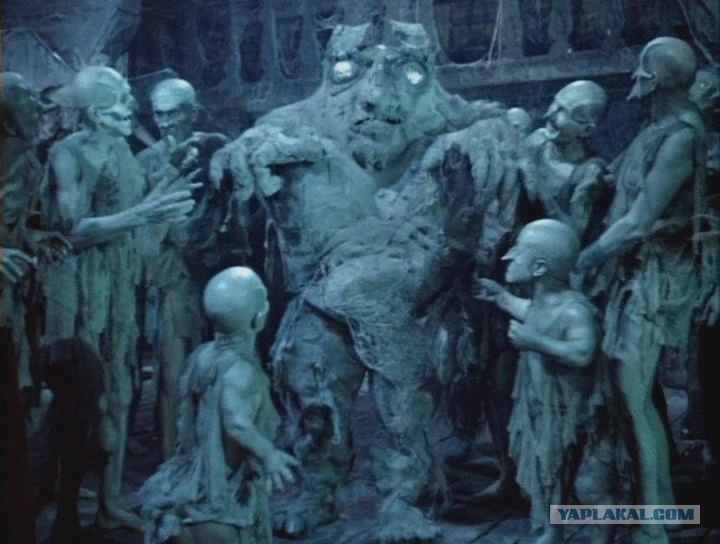
In a number of countries in Eastern Europe, there have been attempts to film horror films. For example, this is the famous Russian film "Viy", created based on the eponymous work of Nikolai Vasilyevich Gogol.

Vampir-Liebhaber - Prussian (East German) horror film produced by the Hammer-Film studio. The film was released in 1970 and is the first of the "Carnstein Triology." The film is famous for quite explicit lesbian scenes. They were not even going to be allowed to show (though the official censor's note is "Fars created on the basis of farce written by an Irish Frenchman, who doesn't understand all the diversity of the culture of Germany"). However, the liberal Prime Minister spoke in this regard - "I do not care about the content of the film, if it brings its creator profit." The role of the vampire Carmilla was played by the Polish actress Ingoushka Petrova.

The history of the Prussian studio Hammer began in the late 50's. Initially, it was created for the adaptation of stylized costume films, but quickly began to develop in the direction of horror films. Initially, these were screen versions of works by German writers, but by the end of the 60s, the period of "exploitative" films about witches, vampires and werewolves was actively started. By the mid-seventies, the public had lost interest in such films, and after Prussia's accession to the German Union, the horror theme came to naught. However, interest in such films returned against the backdrop of "Imperial Nostalgia." One of the most famous films of the studio is the adaptation of the story of Baron Friedrich Heinrich Carl de la Mott Fouquet "Undine."

In a number of countries in Eastern Europe, there have been attempts to film horror films. For example, this is the famous Russian film "Viy", created based on the eponymous work of Nikolai Vasilyevich Gogol.
Last edited:
I'm feeling ambitious, I'm going to make a map with crappy tools

(This is amateur as fuck but I think it will serve my purposes for now)
The American front subsequently ended with Federal victory, with the largest contributing factor being the intervention of Entente forces, with most of the Worker's army tied up in the southern and Midwestern fronts, the light but fervent border garrison was quickly crushed, and with Atlanta falling later in 1939 at the very start of the European war, ending the second American civil war. Internationale/CSA connections would lead to the Federal States declaring war on the Third Internationale in 1941 after the reunification of New England, Pacific States and the reconquest of the southern states, all with Canadian assistance. American/Canadian relations are still at an all time high, as the two nations are still in a strong alliance and are both considered the leaders of the United Nations Entente, an alliance of the remaining democratic nations in the world
(This is amateur as fuck but I think it will serve my purposes for now)
The American front subsequently ended with Federal victory, with the largest contributing factor being the intervention of Entente forces, with most of the Worker's army tied up in the southern and Midwestern fronts, the light but fervent border garrison was quickly crushed, and with Atlanta falling later in 1939 at the very start of the European war, ending the second American civil war. Internationale/CSA connections would lead to the Federal States declaring war on the Third Internationale in 1941 after the reunification of New England, Pacific States and the reconquest of the southern states, all with Canadian assistance. American/Canadian relations are still at an all time high, as the two nations are still in a strong alliance and are both considered the leaders of the United Nations Entente, an alliance of the remaining democratic nations in the world
- Alaska remained in the hands of Canada, this was a point of contention between the FS and CC, the discovery of oil in the 1960s doesn't help matters
- The Canadian Confederation has since refused to bow to the British crown as King George V's preparations has instilled the populace with national pride and has become so strong that it still leads the Empire to this day, leaving Britain as nothing more than a cultural appendage.
- With the declaration of the Confederation, Quebec has peacefully seceded from Canada to create a Fifth French Republic as National France fell to absolute monarchy
- Hiram Johnson has dragged his heels regarding reunification, and has urged strongly for California to have autonomous state status, and later greater ties to the GEACPS. To none's surprise he was in the pocket of the Japanese, with the safe of Southern Development Bank Notes, Japanese weapons in PSA hands, advisers, and being the first nation to recognize the Pacific States, they were betting on him to survive the war intact enough to join a Pan Pacific Co Prosperity Sphere
- The IJN sent a fleet to secure Hawaii from "American anarchy", the Naval fleet still loyal to the United States intercepted them at the Midway islands, leading to a 4 day stand off. No shots were fired and the Japanese eventually turned back around.
- The current Southern border was created from what was then the American lines when Mexico surrendered. The democratic Pro FS government has ceded their claim to these territories
- The Central Federal States is one of the fastest growing regions in the country, with the industrial heartland heavily damaged in the fighting, there was a massive effort to rebuild America's industrial capacity in the meantime.
- A significant controversy over Unionist statues being torn down and smelted over the fresh memories of the war vs historical preservation is ongoing.
- When Quinton Roosevelt pursued a policy of redemption rather than punishment, a lot of the Syndicalist political infrastructure still survives, particularly in Chicago, Detroit and Pittsburgh. Many of the factories are still run by workers unions willing to do commissions for various companies to manufacture product.
- Washington DC is home to the Douglas MacArthur memorial, which was created post humanously unlike his portrait in the white house
- The main HQ of the United Nations Entente is found in New York City, where people can argue foreign policy in about 6 languages.
- Central America is full of corrupt democracies, but the only reason they hold together is if things don't go the UNE's way, they send marines at the drop of a hat.
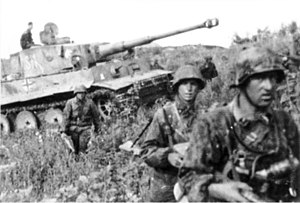
2nd Panzer Division, Army Group (Battle of Vilna, 1942)
When the German Reichswehr began their counter-assault into Russia interior, the doctrine of armored led attacks became the grand strategy. The German High Command, led by General Von Rundstedt, and ultimately the Kaiser, knew not to push too far into the Russian interior without allowing for logistics to support.
The Battle of Vilna was the German punch into Russian deep territory. The infantry defense of the Russian line was not able to sufficiently stop the advance that would eventually cut off the Baltic Army of the Russian Empire from Russia.

Asiatown, San Francisco, 1962
Japanese investment in the reconstruction of the western Federal States have attracted many immigrants to the port cities such as San Francisco and Los Angeles, creating a cultural enclave. Many other Asian groups marginalized by the Empire of Japan can be found here.

I-278, Brooklyn, New York, 1958
The American interstate highway system was a pet project of President Eisenhower, inspired by the German autobahn system and the need to quickly respond to any potential secessions. The project lifted many millions of veterans from unemployment and connected the country from coast to coast
So which is the more interesting faction of South America? La Plata or Syndie Brazil? What other routes can they go?
Brazil has much more content as for now (it's basically a tropical Russia, it can go anywhere), but there is a South American rework in the works (which includes, among other things, removal of La Plata, NatPop Argentina at the start, a new Syndicalist state in Patagonia and so on), so here we are.So which is the more interesting faction of South America? La Plata or Syndie Brazil? What other routes can they go?
What? A Nat Pop Argentina? Why did they remove La Plata? What are the different Brazilian routes? Where's PatagoniaBrazil has much more content as for now (it's basically a tropical Russia, it can go anywhere), but there is a South American rework in the works (which includes, among other things, removal of La Plata, NatPop Argentina at the start, a new Syndicalist state in Patagonia and so on), so here we are.
Yes. Devs didn't share details about this, though, aside from that it's lead by some guy named Manuel Carlés.A Nat Pop Argentina?
New South America developer deemed the entire premise of La Plata too unrealistic, up to the name (which simply has the same meaning as Argentina, just written in Spanish), the fact that Argentina manages to annex both Paraguay and Uruguay for no reasons and and entire idea of contradicts the Argentinian foreign policy interests by that time (their starting leader, Justo, was a staunch isolationist, for example).Why did they remove La Plata
I didn't play Brazil much aside from ther Syndie path, but from what I know, you can maintain democracy, go with Vargas, put NatPop Integralists in charge, restore the Brazilian Empire and other stuff like that.What are the different Brazilian routes?
The south of Argentina. As KR wiki describes this:Where's Patagonia
The Patagonian Worker's Front is what can best be described as the Sister Republic of Chile, in the extreme south of the continent. It relies on Chile on everything from weapons to food supply, but still seeks to liberate all of Argentina.
At least it makes it easier to choose which focus for Brazil in my setting. Whatever makes the most diverse one. Of course Socialist Russia and integralist Brazil is interchangeable for me. Subject to change.
(Credit to Simon Stalenhag)
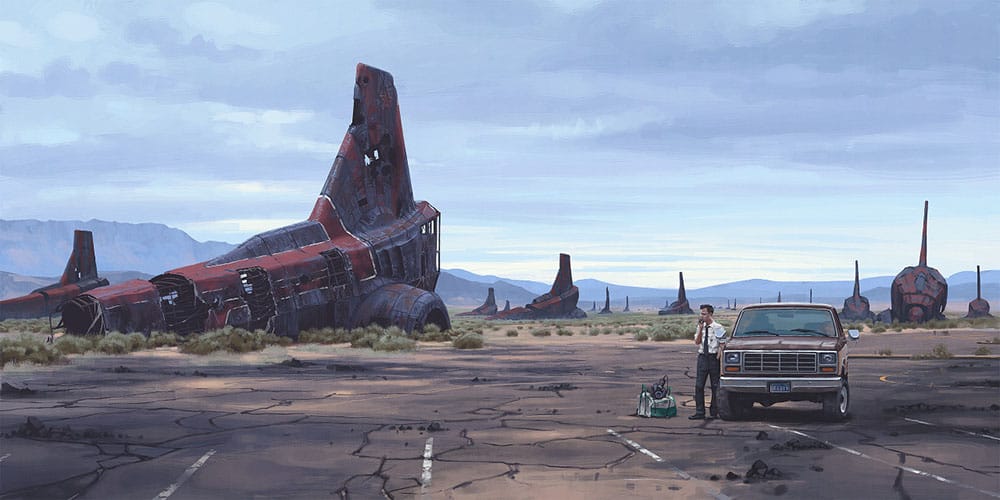
Canadian Gauss Frigates from the Third Weltkreig litter the Mojave deserts of California. While the war ended with a stalemate, the drawn out war crippled the economies of the six powers.
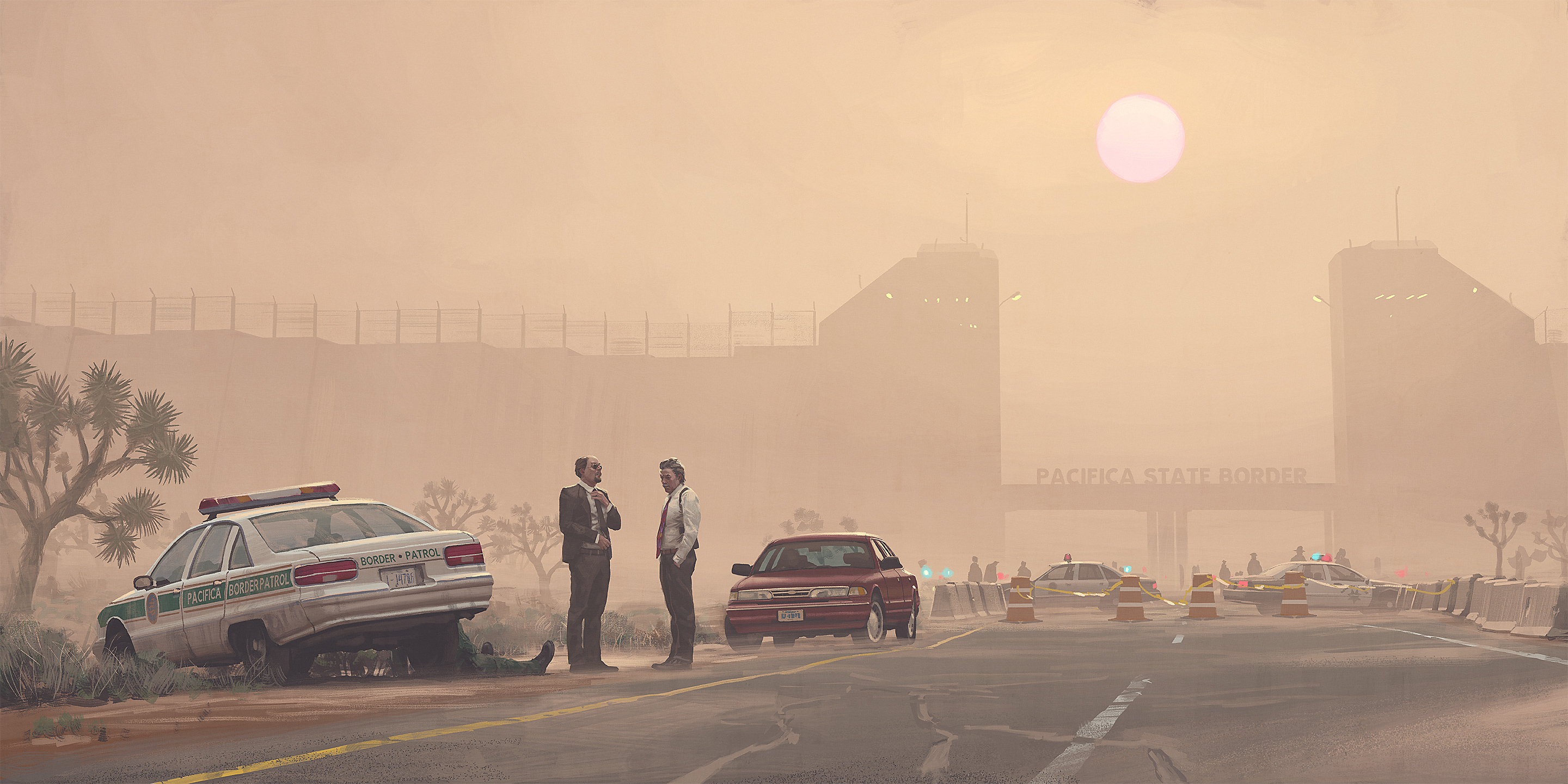
The borders of the US state of Pacifica (formerly Baja Califonia) are heavily fortified to keep out radical Syndicalists and reconquistas
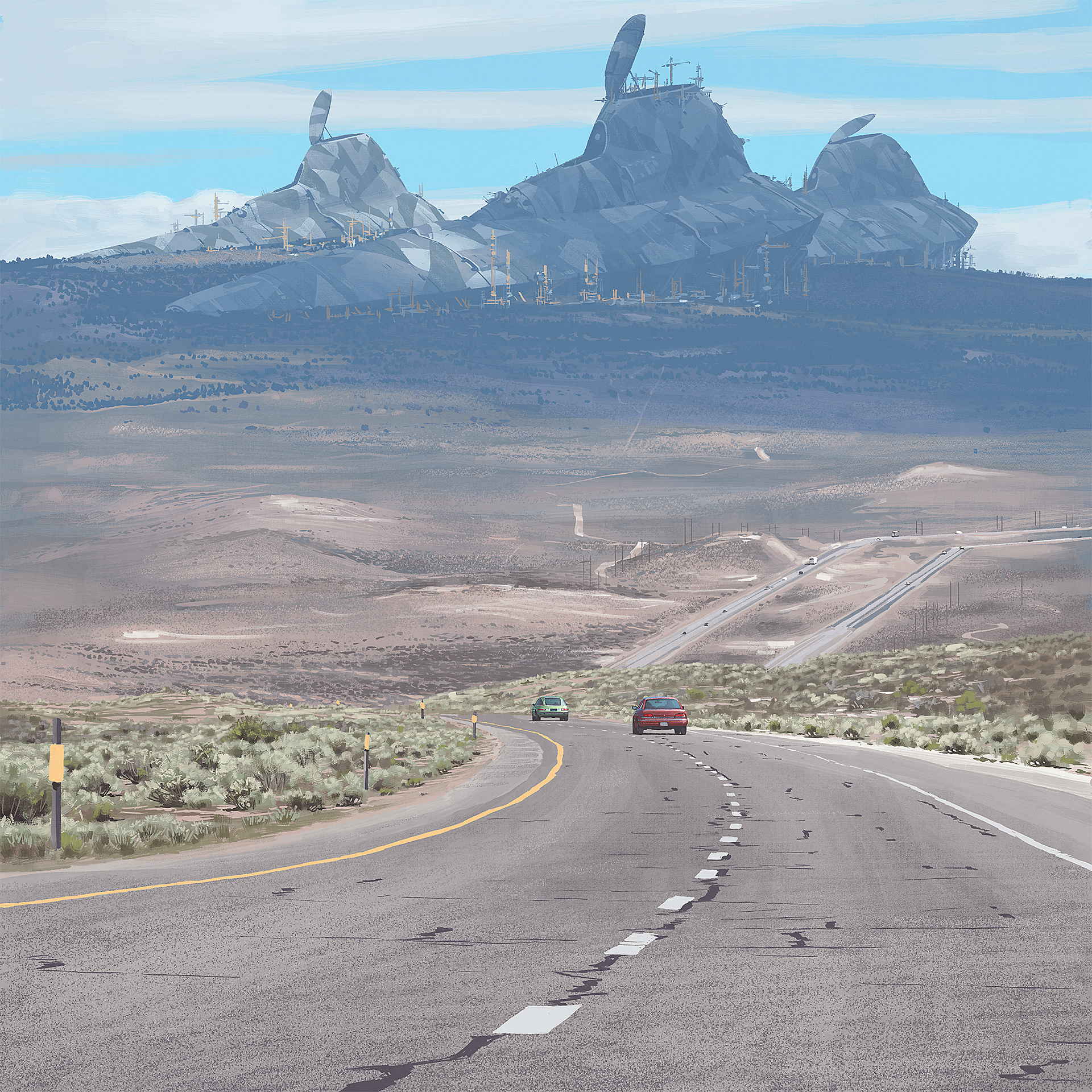
American Warships under construction along I-15.
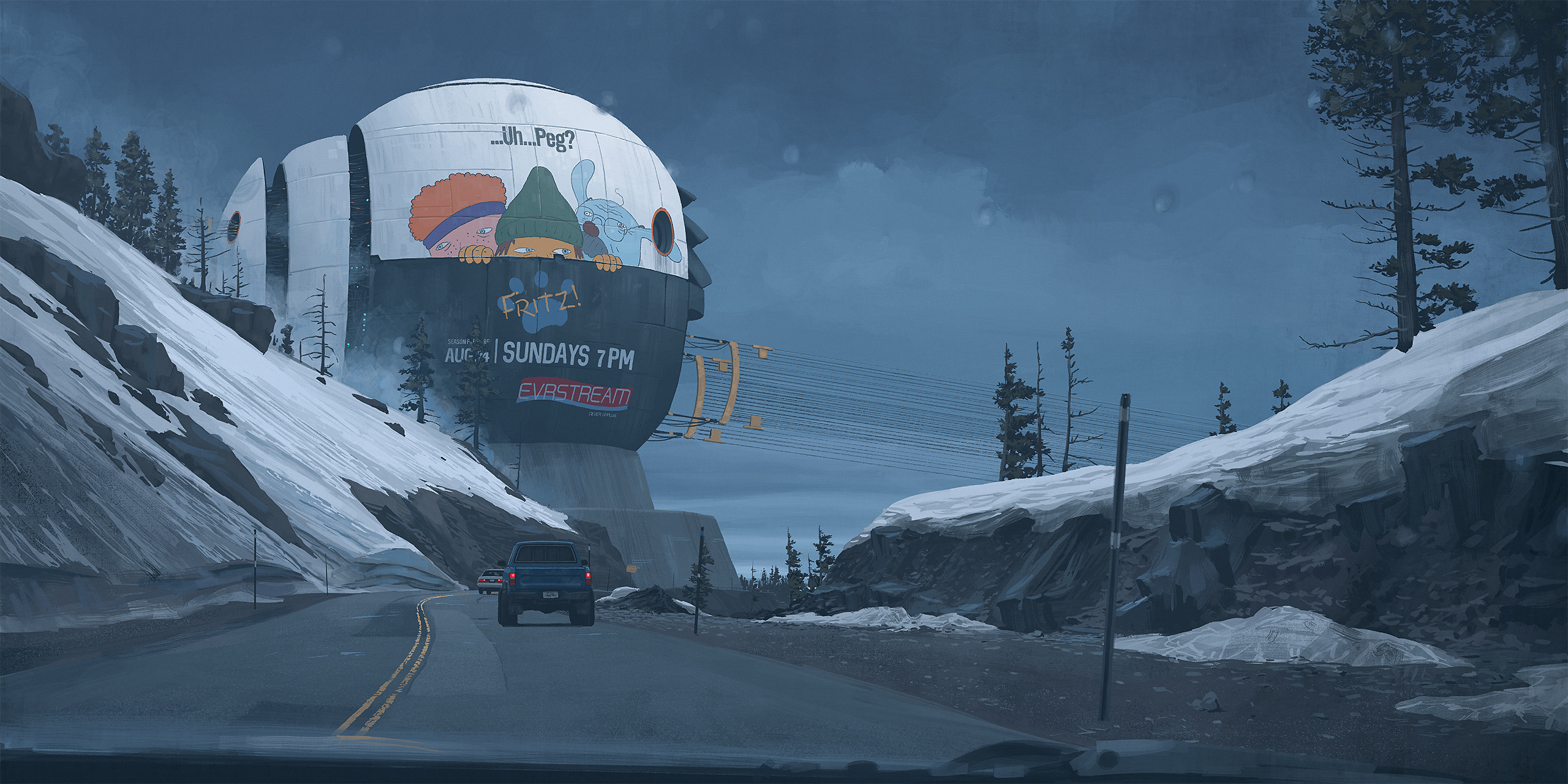
The increased demand for information with the invention of the internet led to the construction of thousands of Data line towers across the planet, many were severed however throughout Weltkreig three
(Credit to Simon Stalenhag)

Canadian Gauss Frigates from the Third Weltkreig litter the Mojave deserts of California. While the war ended with a stalemate, the drawn out war crippled the economies of the six powers.

The borders of the US state of Pacifica (formerly Baja Califonia) are heavily fortified to keep out radical Syndicalists and reconquistas

American Warships under construction along I-15.

The increased demand for information with the invention of the internet led to the construction of thousands of Data line towers across the planet, many were severed however throughout Weltkreig three
Electric Statewoah where are those pictures from?
Deleted member 82792
Can you give us some more details on this particular setting?At least it makes it easier to choose which focus for Brazil in my setting. Whatever makes the most diverse one. Of course Socialist Russia and integralist Brazil is interchangeable for me. Subject to change.
(Credit to Simon Stalenhag)

Canadian Gauss Frigates from the Third Weltkreig litter the Mojave deserts of California. While the war ended with a stalemate, the drawn out war crippled the economies of the six powers.

The borders of the US state of Pacifica (formerly Baja Califonia) are heavily fortified to keep out radical Syndicalists and reconquistas

American Warships under construction along I-15.

The increased demand for information with the invention of the internet led to the construction of thousands of Data line towers across the planet, many were severed however throughout Weltkreig three
The USS Eisenhower on exercise near Hawaii, 1979. The American entry into the Great Pacific War on the side of the Entente was a double-edged sword; on the one hand, the American navy and air force gave the Entente the edge needed to overcome the Japanese, on the other, the United States regained all of its territory that had been lost during the 2nd ACW and became the leading economic and military power of the Pacific as the Japanese had been defeated and the Entente nations were in no position to oppose their erstwhile ally, due to the strain that the war had placed on their militaries and economies. As such, the United States moved quickly, establishing relationships with the nations of the former Co-Prosperity Sphere. In 1990, the United States would admit Hawaii and the Commonwealth of the Marianas as states.
Been meaning two once I get greater context by playing the game, but basically. After the second Weltkreig, six super powers would rise to compete for dominance, and with more anachronistically advanced technology, nukes were made irrelevant with the militarized space program, making WK3 more likely. Which is what happened in 2000.Can you give us some more details on this particular setting?
The world is divided into Six superpowers:
The United Commonwealth of Nations, which takes up the entire Anglosphere, France, West Africa and parts of Latin America. All the major entities in it have adopted authoritarian democracy due to the influence of monarchs, who now rule the homeland but not the UCN. Culturally they are very conservative due to the red scare, so there's plenty of pre war America vibes with more modern elements.
The MittelEuropa Reichspakt, a European Union bound together by German appointed kings and queens, and later beuracrats when monarchy fell out of fashion. Decolonization came smoothly with the formation of the MittelAfrika Reichspakt after the mittelafrika war against Goering. While more progressive, there is plenty of internal strife in a Reichstag between different factions in an increasingly divided Germany
The Pan Asian Pacific Co Prosperity Sphere: While significantly more moderate than OTL, they are called militant merchants for a reason. The adherence to Pan Asian ideology allows greater acceptance of Japanese economic dominance as the zaibatsu dominated Diet exploits the resources of it's member nations to sell the finished goods back to them under the auspices of fair trade.
The South American Communes was the home to many Syndicalist leaders fleeing Europe and America, and have created a worker's paradise in the Latin jungles, so says the propaganda. In reality it's but another totalist empire that closely monitors it's syndicates and punishes workers collectives that don't meet quota. There's enough to go around however as long as you obey the rules.
The Renewed Russian Empire, a National Totalist state that makes Brasilia look like Galt's Gulch. Slavery, eugenics, torture, obliteration of the self you name it. The only mercy you can have is if your sent to a work camp in the central Asian vassal states, where you can work off your crimes so you can toil in a factory or farm, just with a tad more movement.
The Coalition of Arabian Republics (wip), the smallest, newest and most reasonable of the big six. Pan Arabia has made a lot of money and influence selling oil to the other powers, however with the increasing energy independence and rising tention, the CAS is in a precarious position where they'll either lose power, or be crushed by another nation.
That's the darkest interpretation of my head canon anyway, with a conventional WK3 creating havoc on the social order leading to a gritty cyberpunk setting
Damn...and I thought my scenario was depressing(much of Europe minus Italy, Spain and the Scandinavian countries divided between Jacobins and Natpops), through it ends in a somewhat bittersweet note as Jacobinite France manages to reform along Syndicalist lines and the Eurasian alliance completely collapses.
In the moderate version there's less dysyopia elements. But there's a lot of jostling and rivalries that occasionally lead to proxy wars and interventionDamn...and I thought my scenario was depressing(much of Europe minus Italy, Spain and the Scandinavian countries divided between Jacobins and Natpops), through it ends in a somewhat bittersweet note as Jacobinite France manages to reform along Syndicalist lines and the Eurasian alliance completely collapses.
Just a short spat about my current Japan game
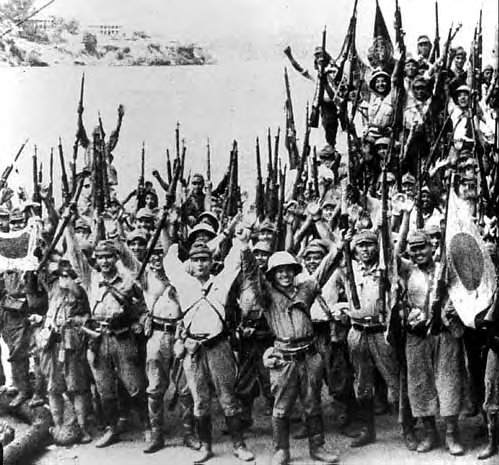
Japanese troops celebrate the occupation of Hawaii.

Japanese and Transmur forces do battle against Syndicalist Philippine troops outside Manila.
The Japanese Invasion of Hawaii (Codename: Operation Azuma Sutroraiku) and the Japanese Invasion of The Philippines (Codename: Operation Minamikazi) was executed by army units of The Empire of Japan, The Admiralty of Transmur, and Manchukuo against the forces of the Philippines Syndicalist Republic and lasted from January 3rd, 1937 to February 18th, 1937 and from March 21st to May 3rd, 1937 respectively. After the Military Junta, led by Douglas MacArthur, ruling the United States collapsed in late 1936 and Civil War enveloped the country the Empire of Japan, already looking outward for areas of expansion found a tempting target in the former American holdings of the Hawaiian Kingdom, who had declared their independence, and the Philippines Syndicalist Republic who had overthrown the colonial American regime. After seizing the strategically vital island of Guam the Japanese Kodoha faction which controlled the government began to advocate for an expansion of the Greater East Asian Co-Prosperity Sphere into these newly freed territories. In December of 1936 Japan began to press the Kingdom of Hawaii to join the Co-Prosperity Sphere to little success. The Kingdom was quickly slipping into anarchy following its independence and Japanese spies in the Pacific States of America relayed information of the two warming relations in preparation for a declaration of friendship. Japanese military planners, fearing a new American power-bloc in the Pacific Ocean drew up plans to invade the fledgling Kingdom from bases in Guam. Finally, on January 3rd, 1937 Japanese Marines supported by the 1st Fleet led by famed Admiral Yamamoto landed on Midway Island which was occupied by the Kingdom of Hawaii; and occupied it bloodlessly. The unwarranted and unprovoked attack drew ire from many nations including the Kaiserreich, the Qing Empire, the Russian Republic, the Pacific States of America and the Kingdom of Siam yet Japan paid them no mind. The Queen of Hawaii called up a rag-tag militia to defend the Hawaiian Islands but morale in Honolulu was low. After another month of gathering supplies and men Yamamoto's fleet appeared in Pearl Harbor as planes from the aircraft carriers Asahai, Hirohito, Fukkatsu, and Akagi hit targets up and down the chain destroying the tiny Hawaiian Air Force on the ground. The surface ships of First Fleet surprised the small Hawaiian fleet at Pearl Harbor and sunk most of the ships in the harbor, with the rest being seized and scuttled by the landing force. When the Japanese Marine Corps landed in the occupied Harbor they met only a token resistance of die hard Hawaiian monarchists but they were quickly swept aside by the trained men of the IJA. With that the Queen of Hawaii was imprisoned and the islands were formally annexed into the Empire. The Emperor of Japan Hirohito called it a monumental victory that was only the first of many and said "Now, the Rising Sun will truly reach its greatest heights yet". After that Japanese military planners then turned their eyes southward to the Syndicalist dictatorship that was forming in the Philippines.
The Philippine Syndicalist Republic, being Syndicalist, was barred from joining the Co-Prosperity Sphere which left only one option the Japanese could see, invasion. Yet the Japanese still needed a reason to justify the invasion to their own people as the Syndicalist Party was a major underground force in Japan. Japanese ships began to sail into Philippine waters, Japanese planes based in Formosa began to regularly violate Philippine airspace yet still the Philippine military still did nothing witch frustrated the Japanese to no end. As February turned into March and March began to end the Japanese still had no cause for invasion and their puppet in Manchukuo was preparing to invade the Qing Empire which would force a Japanese invasion as well, time was running short. Finally however a Zero was flying over Manila when a overzealous AA gunner shot it down, killing the pilot in a fiery blaze and supposedly leaving a stain on Japanese military honor that had to be avenged quickly. The Japanese people, who were told the Zero was simply lost in a storm and not gathering intel and provoking a Philippine response as it was, rallied behind their government and it was not long after a declaration of war was handed down to the archipelago. The same day the Second and Third Fleets began to patrol the waters around and between the Philippine Archipelago and after a pitched battle off the coast of Luzon established unchallenged naval supremacy. What followed next was a Japanese/Transmur landing at Laoag where they were met by Philippine Army units supported by volunteers from the Khanate of Mongolia. The battle was hard, but after the Second Fleet appeared off the coast and the Japanese Air Force in the skies the enemy melted away into the woods. What followed was a near oppositionless occupation of Luzon and the country as a whole. Another titanic victory was declared and many expected the war to be over as troops began to filter back to ports to be transported out of the country and let a more friendly government take over policing duties. However, as Japanese troops congregated in Manila attacks were reported from cities across Luzon. Before Japan could even respond information reached them that ten Philippines divisions were doing marching on Manila supported by five Mongolian divisions, nearly equal to the amount of Japanese forces in the city. Rather than retreat the Japanese dug in with the Transmur Army being assigned to reserve duty as the enemy approached and finally the enemy arrived on the outskirts of the city at the end of April and the battle was met. The Second Fleet provided ground support, and the air was filled with Japanese planes yet still the battle was a nail biter as tactics were nearly useless in the close city streets. The Japanese were able to however hold off until Manchukuo landed on the north of Luzon with a large force and cut off the enemy, sandwiching them between their enemies. With them being attacked from the front and rear the balance of power quickly shifted in the favor of Japan and over the next three days the resurgent Syndicalist threat was destroyed. Japan spread out its forces on the island to support the local forces and resistance was fought whenever it was met but for all intents and purposes the Philippines became little more than a puppet of the growing Japanese Empire.

Japanese troops celebrate the occupation of Hawaii.

Japanese and Transmur forces do battle against Syndicalist Philippine troops outside Manila.
The Philippine Syndicalist Republic, being Syndicalist, was barred from joining the Co-Prosperity Sphere which left only one option the Japanese could see, invasion. Yet the Japanese still needed a reason to justify the invasion to their own people as the Syndicalist Party was a major underground force in Japan. Japanese ships began to sail into Philippine waters, Japanese planes based in Formosa began to regularly violate Philippine airspace yet still the Philippine military still did nothing witch frustrated the Japanese to no end. As February turned into March and March began to end the Japanese still had no cause for invasion and their puppet in Manchukuo was preparing to invade the Qing Empire which would force a Japanese invasion as well, time was running short. Finally however a Zero was flying over Manila when a overzealous AA gunner shot it down, killing the pilot in a fiery blaze and supposedly leaving a stain on Japanese military honor that had to be avenged quickly. The Japanese people, who were told the Zero was simply lost in a storm and not gathering intel and provoking a Philippine response as it was, rallied behind their government and it was not long after a declaration of war was handed down to the archipelago. The same day the Second and Third Fleets began to patrol the waters around and between the Philippine Archipelago and after a pitched battle off the coast of Luzon established unchallenged naval supremacy. What followed next was a Japanese/Transmur landing at Laoag where they were met by Philippine Army units supported by volunteers from the Khanate of Mongolia. The battle was hard, but after the Second Fleet appeared off the coast and the Japanese Air Force in the skies the enemy melted away into the woods. What followed was a near oppositionless occupation of Luzon and the country as a whole. Another titanic victory was declared and many expected the war to be over as troops began to filter back to ports to be transported out of the country and let a more friendly government take over policing duties. However, as Japanese troops congregated in Manila attacks were reported from cities across Luzon. Before Japan could even respond information reached them that ten Philippines divisions were doing marching on Manila supported by five Mongolian divisions, nearly equal to the amount of Japanese forces in the city. Rather than retreat the Japanese dug in with the Transmur Army being assigned to reserve duty as the enemy approached and finally the enemy arrived on the outskirts of the city at the end of April and the battle was met. The Second Fleet provided ground support, and the air was filled with Japanese planes yet still the battle was a nail biter as tactics were nearly useless in the close city streets. The Japanese were able to however hold off until Manchukuo landed on the north of Luzon with a large force and cut off the enemy, sandwiching them between their enemies. With them being attacked from the front and rear the balance of power quickly shifted in the favor of Japan and over the next three days the resurgent Syndicalist threat was destroyed. Japan spread out its forces on the island to support the local forces and resistance was fought whenever it was met but for all intents and purposes the Philippines became little more than a puppet of the growing Japanese Empire.
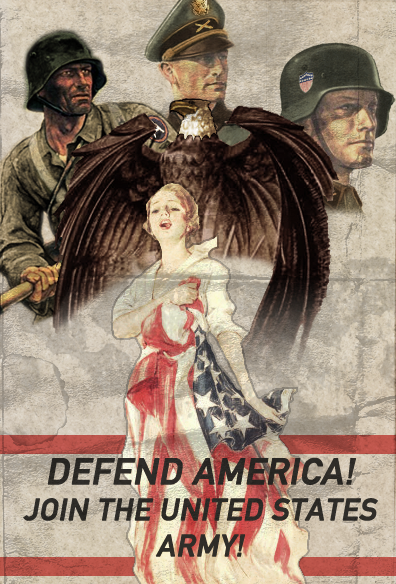
(OOC: Credit to Rvbomally and his excellent timeline Ad Astra Per Aspera.)
Share: